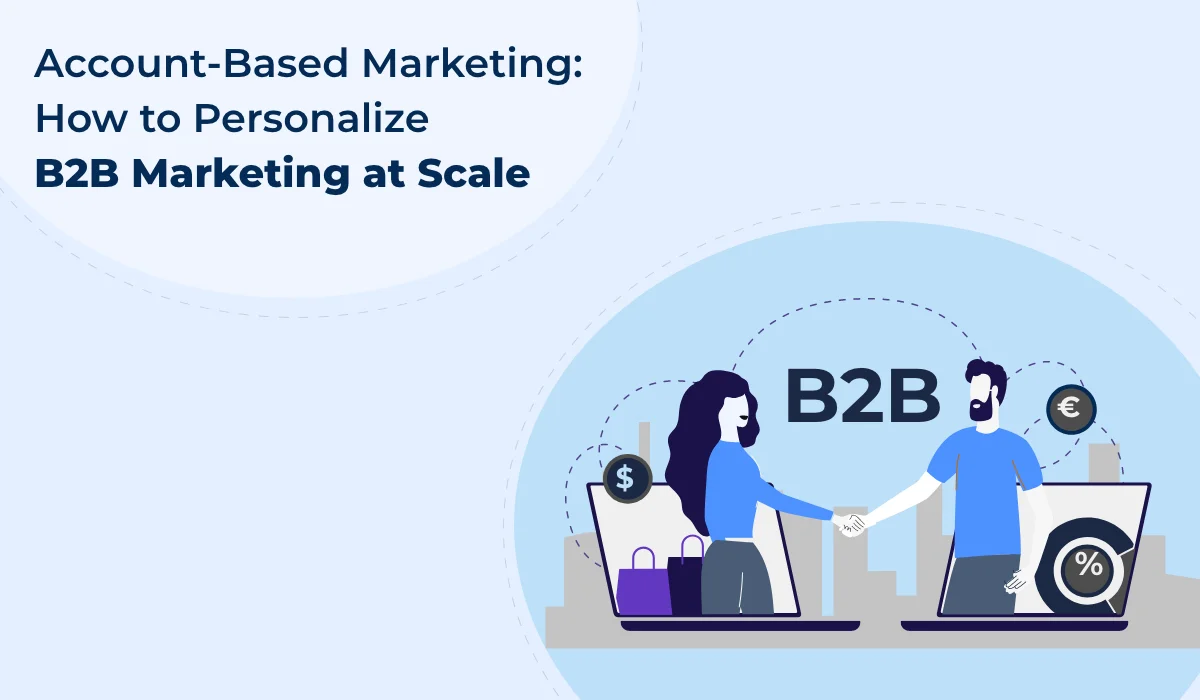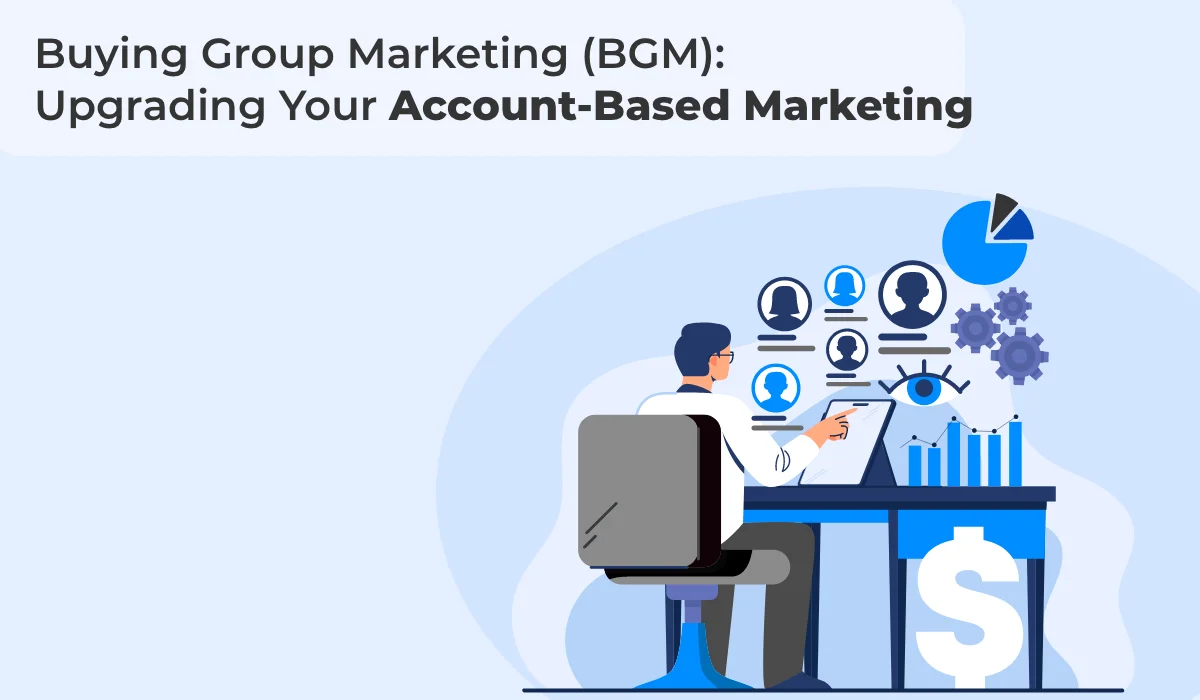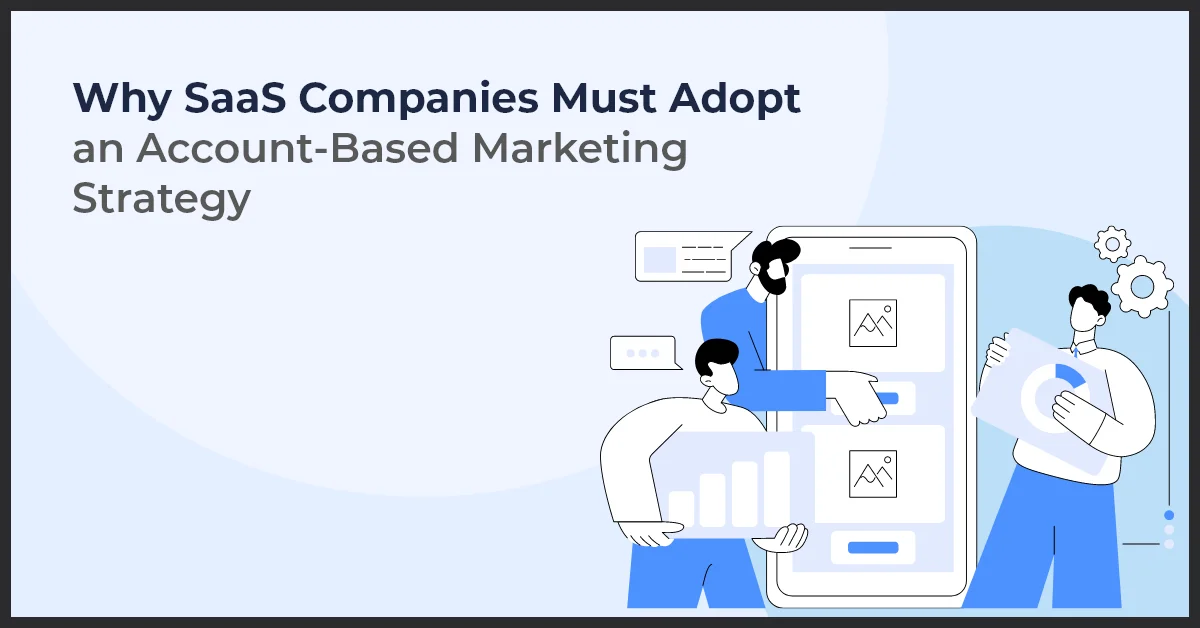Top ABM Metrics to Track for a Successful Campaign

Published on: May 11, 2022
Updated on: March 04, 2025
2619 Views
- Account Based Marketing
17 min read
Welcome to our guide on Account-Based Marketing (ABM) metrics – the secret sauce to skyrocketing your revenue! In a competitive landscape, ABM has emerged as a powerful strategy that enables companies to personalize their marketing efforts and drive success on a one-to-one basis.
ABM is a strategic approach that focuses on targeting specific accounts rather than casting a wide net. By aligning marketing and sales efforts towards high-value accounts, businesses can create tailored experiences that speak directly to their prospects' needs, making it a key differentiator in today's customer-centric era.
However, embarking on an ABM journey without measuring its impact is like driving blindfolded – risky and counterproductive. To unlock the full potential of ABM, it is crucial to arm yourself with the right metrics. In this guide, we will explore the importance of measuring ABM metrics and how they can fuel your path to success.
Understanding ABM Metrics
In order to effectively implement an account-based marketing (ABM) strategy, it is crucial to understand ABM metrics and their significance. ABM metrics are key performance indicators that help measure the success and impact of your ABM efforts.
These metrics provide insights into the effectiveness of your account targeting, engagement, and overall marketing efforts. By tracking and analyzing ABM metrics, you can make informed decisions, optimize your strategies, and achieve better results.
One of the significant connections between ABM metrics and sales cycles is that ABM metrics help shorten the sales cycles. By focusing on specific high-value accounts and aligning sales and marketing efforts towards them, ABM strategies can efficiently move prospects through the sales funnel.
Account-Based Marketing Success with Metrics
Utilizing ABM metrics is essential for driving success in account-based marketing. By measuring and analyzing the right metrics, businesses can gain valuable insights into their ABM campaigns and make data-driven decisions for better results. Here are some tips on how to leverage ABM metrics to achieve success:
1. Define Your Goals
Before diving into ABM metrics, it's crucial to define your goals. What do you want to achieve with your account-based marketing efforts? Is it increasing revenue, improving customer retention, or expanding into new markets? By having clear objectives, you can align your metrics with your goals, making it easier to track progress and measure success.
2. Identify Key ABM Metrics
Not all metrics are created equal when it comes to ABM. It's important to identify the key metrics that are most relevant to your specific goals and target accounts. Some common ABM metrics include:
- Account Engagement: Measure the level of engagement your target accounts have with your marketing campaigns.
- Opportunity Velocity: Track how quickly opportunities progress through the sales funnel.
- Deal Velocity: Measure the time it takes to close deals and generate revenue.
- Customer Lifetime Value: Understand the long-term value of your customers to inform strategic decisions.
3. Monitor and Analyze Metrics Regularly
Once you've defined your goals and identified the key metrics, it's essential to monitor and analyze them regularly. Set up a system to track and measure the selected metrics, such as utilizing analytics tools or CRM software. Regular monitoring will allow you to spot trends, identify areas for improvement, and optimize your ABM strategies accordingly.
4. Learn from Case Studies and Success Stories
Looking at real-life examples of successful ABM campaigns can provide valuable insights and inspiration. Explore case studies or success stories from companies that have implemented ABM metrics effectively. Learn from their experiences, strategies, and outcomes to gain a deeper understanding of how ABM metrics can drive success in account-based marketing.
Overall, account-based marketing success heavily relies on utilizing metrics to guide your strategies and measure performance. By defining your goals, identifying key metrics, monitoring and analyzing them regularly, and learning from others' successes, you can maximize the effectiveness of your ABM campaigns and achieve remarkable results.
Top Reasons Why Tracking ABM Metrics Is Key to Getting Better ROI
Account-Based Marketing (ABM) is a strategic approach in B2B marketing that diverges from the traditional method of targeting a wide audience. Instead, it emphasizes building and nurturing valuable relationships with specific businesses.
With ABM metrics, you can get data that helps you in delivering tailored content that addresses the specific needs of your prospects. Each prospect is treated as an individual market, warranting a personalized marketing message.
Rather than creating generic marketing campaigns aimed at a broad audience, ABM metrics help you to hone in on specific businesses that have the potential to become valuable clients. By prioritizing these prospects, you can develop a customized approach for each of them.
ABM can be seen as a refined version of direct marketing, a practice we have employed for decades. However, the key distinction lies in the transition from broad targeting to a more targeted approach.
According to a survey conducted by SiriusDecisions, the adoption of key ABM metrics strategies has significantly increased. In 2017, 81% of the respondents reported implementing ABM, a notable rise from the 49% reported in 2016, indicating a growing trend.
For B2B marketers, revenue generation emerges as the primary objective of ABM campaigns. Other crucial goals include tracking user journey metrics, accelerating pipeline growth, generating leads, and aligning sales and marketing efforts.
So,
What does this mean for salespeople engaged in B2B marketing?
Is ABM difficult?
Does the prevalence of ABM among marketers imply that you should also embrace this strategy?
Not necessarily. These are just a few compelling reasons why you should consider exploring the potential of ABM.
Importance of Account-Based Marketing
Why Account-Based Marketing (ABM) is Vital to Your Marketing Strategy? Let’s find out the answer to this question in the following points.
- Targeted and Effective Campaign: ABM metrics allow you to create highly targeted and effective marketing campaigns. They enable you to focus on specific customers who are most relevant to your business objectives, fostering stronger relationships with them.
- Fuel Growth for Years: ABM has the potential to fuel long-term growth. By investing in ABM, you lay the foundation for sustained success and continued customer engagement that can benefit your business for years to come.
- Incorporates Multiple Channels: ABM goes beyond social media advertising. It encompasses traditional marketing methods like direct mail and email marketing, ensuring a comprehensive approach to reaching and engaging your target audience.
- Leveraging Marketing Automation: Utilizing marketing automation tools is crucial in ABM. These ABM metrics tools assist with lead qualification and prospecting activities, giving you a competitive advantage in your industry and increasing the chances of reaching the right individuals with your offers.
- Crafting Relevant Content: In ABM, relevance is everything. Creating tailored content for qualified customers or prospects is essential. It ensures that your offers resonate with their specific needs and helps you cut through the clutter of traditional advertising techniques.
ABM is not merely a quick fix, but rather a long-term investment that has the potential to yield significant benefits and drive your marketing efforts to new heights.
5 Compelling Reasons to Embrace ABM for Amplifying Sales Success
When you concentrate your efforts on specific accounts with higher conversion potential, you are more likely to succeed. It's about analyzing the ABM metrics data properly and determining the precise number of clients your company can effectively serve and aligning with the ideal scenario.
Here are a few reasons why you should embrace ABM to amplify your ROI.
Laser Focus: The Power of Precision
In the realm of account-based marketing (ABM), precision reigns supreme. By directing your efforts toward a select group of high-potential accounts, you unlock the path to unparalleled success. It's about identifying the precise number of clients your company can serve effectively, aligning with the ideal scenario.
Through unwavering focus, superior results are within reach. It's a logical principle. No longer will you rely on generic email blasts and broad marketing campaigns. ABM thrives on individualized interactions, tailored exclusively to prospects within targeted accounts.
With a razor-sharp focus, the sales and marketing teams synergize, working together to engage these specific accounts in the most meaningful way. By concentrating resources on a handful of businesses, they ensure that the right messages reach the right prospects, maximizing their chances of success.
Unifying Sales and Marketing Efforts
In theory, sales and marketing departments should always collaborate seamlessly. However, real-world experiences often reveal a lack of cohesion as these teams pursue a shared goal through separate avenues. Research from Content Marketing Institute and LinkedIn indicates that highly aligned companies—where sales and marketing closely collaborate on content strategies—account for 81% of marketers, while only 25% exist in low-aligned companies.
The intriguing finding from this research is that ABM is a clear indicator of alignment. A staggering 57% of highly aligned companies have embraced ABM as a part of their marketing endeavors. ABM necessitates high-quality content tailored to specific accounts, forging a direct link between personalization and success.
Common obstacles to collaboration include conflicting internal incentives, divergent approaches to measuring results, geographical distance between teams, the use of disparate technologies, and a lack of regular meetings.
So, how does ABM overcome these hurdles? It provides a shared goal: personalization. Marketers delve deep into researching their target audience's needs, exploring avenues to connect with them. For the sales team, it's about understanding leads and delivering personalized content that ignites buying decisions. ABM becomes the meeting point where these two teams converge, creating a seamless collaboration.
Driving ROI: The Power of Results
The return on investment (ROI) stands as a persuasive argument in favor of ABM. Remember the statistics we mentioned earlier? The primary motivation for B2B marketers adopting ABM is revenue generation. They invest in this approach with the expectation of not only recouping their investment but also generating substantial revenue.
How is this objective achieved? Through ABM, the marketing and sales teams align their efforts and conduct a consistent campaign. This eliminates unnecessary costs, enabling them to achieve results while minimizing marketing expenditures.
ABM strategy encourages sales by offering personalized solutions tailored to specific needs. It's a customer-centric approach, and therein lies its immense value. As the team measures ABM's performance, they identify and reinforce the most effective strategies. With a highly focused and targeted campaign, insights are easily measured. Successful content approaches are recognized, while unsuccessful attempts are adjusted.
ABM marketing doesn't demand excessive time to deliver tangible outcomes. Identifying potential client companies and implementing an account-based approach is a much faster strategy compared to broader online branding efforts. Once businesses are identified, personalized offers tailored to their specific needs pave the way for rapid acceptance.
Personalization: The Art of Captivation
What makes ABM irresistible to clients? Personalization. Imagine you're a business owner, running a private language learning school. You receive a customized offer from a cleaning company that proposes daily cleaning services after your classes. They outline the benefits precisely, offer flexibility to accommodate your preferences, and assure you of using only organic cleaning products that won't harm children's health. They even offer to adjust their practices if any of the kids have allergies to specific ingredients. On top of that, they present an affordable price, showcasing the immense value you would gain by making your school more appealing to new users.
Now, that's an offer that's hard to resist, isn't it? ABM has a remarkable ability to captivate through attention to detail. Its essence lies in highly personalized marketing, immediately piquing the interest of potential clients.
Of course, achieving such personalization requires extensive research by the marketing and sales teams. Once you have a firm grasp of your prospects, you can target them based on their likelihood of conversion and develop tailor-made offers with a high probability of success.
Deepening Client Understanding: The Path to Success
A successful ABM strategy hinges on comprehensive yet focused research in ABM metrics. Instead of reaching out to a broad target audience, you engage with specific businesses that have the potential to become your clients. This narrower focus grants you the opportunity to truly understand what sparks their interest.
Consider the earlier example of the language school, but this time you represent the cleaning service. If you identify the language school as a potential client, you would conduct thorough research on them. You would learn about the number of students and classes they have each day, and delve into their core values. If they prioritize a clean environment, you would tailor your cleaning services to align with those values.
Through direct communication with the prospect, you can craft an even more compelling offer. If they express interest, the business owner or relevant employee may have specific queries or requests. Perhaps they ask you to modify something in your offer, and you can easily accommodate their needs.
For instance, if they inform you that one of the children has asthma and reacts to the scent of mint, you can ensure that your cleaning products do not contain mint-based ingredients. With personalized offers that cater to the client's requirements, you can adapt your strategies accordingly.
Account-based marketing goes beyond superficial interactions. It allows you to truly understand and connect with your clients on a deeper level, fostering long-lasting relationships built on trust and customized solutions.
In a nutshell, ABM offers a myriad of benefits that can significantly enhance your sales endeavors. By focusing on key ABM metrics, you can add significant value to your efforts, align sales and marketing, drive ROI, embrace personalization, and deepen client understanding.
By following the steps mentioned above, you can unlock the potential for extraordinary success. Embrace the power of ABM and embark on a transformative journey toward amplified sales achievements.
Now that you have a clear understanding of why ABM metrics are important and how ABM itself can prove to be a game changer, let’s look at the ABM metrics that you should track to determine the success of your campaigns.
Elevate your marketing with DiGGrowth's ABM Dashboard! Email us at info@diggrowth.com for more info.
Tap Into Top 9 ABM Metrics to Determine Your Campaign’s Success
70% of marketers leverage account-based marketing (ABM) today, with 80% of them reporting improved customer lifetime value (CLTV) with it.
ABM definitely outperforms all other marketing activities when it comes to generating maximum returns, but the point where most marketers get stuck is, how to measure and report ABM success?
Tracking conversions is the easy part. Apart from that, thanks to the presence of umpteen channels and customer touchpoints, evaluating your campaigns’ performance can be a real challenge.
Therefore, in this blog post, we will discuss the key metrics that you should track when running your ABM campaign to measure its effectiveness. Let’s begin.
Top 9 ABM Metrics You Should Track
1. Marketing Qualified Accounts (MQA)
One of the key goals of metrics-based marketing is to eliminate the transfer of unqualified marketing leads to the sales team. The benefit is that there are more high-quality accounts in the pipeline; the disadvantage is that it takes more time to scrutinize, analyze, and qualify accounts.
You will need some purposeful qualifying requirements for ABM to be effective. Have your sales and marketing teams come up with a definition for this. Then apply it to your ABM efforts throughout the research and identification phase. Moreover, MQA is significant for benchmarking and upholding qualification standards.
2. Influenced Pipeline
Influenced pipeline is among the most important criteria for measuring the effectiveness of your ABM campaign. It concentrates on whether your ABM activities impacted accounts in your pipeline at any point in time.
The impacted pipeline is a simple statistic to track since as long as you know your target account was affected by any channel in your account-based marketing metrics strategy, you know the campaign is working.
3. Conversion Metrics
Is your intended audience taking the action you want them to take? This is an important ABM metric to track whether your aim for them is to click your ad and fill out a form, request a product demo, or visit your website.
Conversion metrics can aid in identifying key areas for improvement. If your click-through rates are high but your conversion rates are poor, for example, your message may not appropriately reflect the offer on your landing page or website.
4. Account-Based Engagement
One of the effective ways to ensure the success of an ABM strategy is personalization, but personalization is not the only key. It is time to dig further into the activity of target accounts if you are seeing a drop in engagement. Create an engagement model that counts the many ways in which an account engages.
Account engagement is a crucial ABM metric to track while reviewing and tweaking your ABM approach. For instance, if you are having greater success with an account through email marketing, it is time to ramp up your efforts.
5. Average Selling Price
The optimal ABM approach should result in a better ASP (average selling price). This is because sufficient effort and research have been allocated to prospecting the appropriate high-value accounts.
If your ASPs are not rising, you are squandering money on ABM when the previous sales and marketing model would have produced the same outcomes at a larger volume. Measuring ASP as a measure is useful for determining the true value of ABM, as well as analyzing MQAs and establishing product-market fit.
6. Sales Cycle Length
As your campaigns are more customized, targeted, and successful, adopting a metrics-based marketing approach frequently correlates to a shorter sales cycle duration.
Tracking the length of your sales cycle will help you optimize your transaction closing process, even if it is a natural process. Divide the entire duration for each sale completion by the total number of deals to arrive at the average cycle length.
7. Pipeline Velocity
ABM is a bespoke approach to marketing and sales. With ABM, you can see deals closing effectively and rapidly, but you will still be unclear about the efficacy until you have tracked pipeline velocity. In a nutshell, pipeline velocity refers to the time it takes for an average deal to go through the phases and conclude.
If your pipeline velocity for ABM deals is not greater, you should reconsider your ABM initiatives. Pipeline velocity is a useful indicator for discovering sales possibilities and bottlenecks, as well as determining how long it takes to achieve a final yes/no decision on accounts. It is also useful for analyzing how your current sales cycle compares to prior ones when using an ABM strategy.
8. Customer Churn Rate
ABM is not only for companies, marketers, and sellers; it also provides customers with a better purchase experience. This is why it is essential for you to track the customer churn rate that you acquire through the ABM strategy.
Moreover, tracking churn rate is critical if you want to retain ties with your post-sale customers. After making a contract, creating hyper-personalized advertising and engaging deeper with your accounts will assist in preventing churn.
9. Return on Investment
87% of marketers believe that ABM generates a greater ROI as compared to other marketing tactics. So, another important account-based marketing metric to watch is the return on investment.
At the end of the day, you are trying to figure out how effective your campaign was. You should have standards to go by if you have previous data from your marketing and sales activities.
Before you clinch any business deal, you may want to establish a rough estimate of how much you will need to spend on average when beginning with a new campaign. If your new campaign begins to cost more than typical without a corresponding return on investment, you will need to rethink your strategies.
Final Thoughts
Tracking the KPIs of your campaign is essential to know its impact on your business. Or else, you may end up piling up huge marketing expenses without any valuable returns.
Before running your campaigns, you need a framework that helps track everything from engagement to response to outcome. And ABM is a tried-and-true method.
If you are looking for a trusted ABM partner, our digital marketing experts at Growth Natives have worked with businesses in the past to help them scale with focused ABM efforts. To share your specific needs, shoot us an email at info@growthnatives.com.
Frequently Asked Questions
The Account Engagement Score can be calculated by assigning points to various engagement activities and touchpoints, such as website visits, content downloads, email opens, event attendance, and social media interactions. These points are then aggregated to generate an overall engagement score for each target account.
Measuring ABM campaign success is important to determine the effectiveness of your strategies, optimize future campaigns, and ensure a high return on investment (ROI). It helps in identifying what works and what doesn’t.
Opportunity Win Rate reflects the effectiveness of ABM campaigns by indicating the percentage of opportunities created from target accounts that ultimately result in closed-won deals. A high Opportunity Win Rate suggests that ABM strategies are effectively identifying and engaging with high-value accounts that are more likely to convert into customers.
Ways to maximize return on investment (ROI) in ABM include setting clear goals and objectives for your campaigns, closely aligning marketing and sales efforts, leveraging data and analytics to optimize targeting and messaging, testing and iterating on campaign tactics, and regularly evaluating performance and adjusting strategies based on results.
Tools for tracking ABM metrics include marketing automation platforms like Marketo, HubSpot, and Pardot, as well as CRM systems like Salesforce, and analytics tools like Google Analytics and Tableau.



